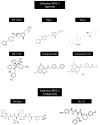Bombesin receptor subtype 3 as a potential target for obesity and diabetes
- PMID: 26066663
- PMCID: PMC5417335
- DOI: 10.1517/14728222.2015.1056154
Bombesin receptor subtype 3 as a potential target for obesity and diabetes
Abstract
Introduction: Diabetes mellitus and obesity are important health issues; increasing in prevalence, both in the USA and globally. There are only limited pharmacological treatments, and although bariatric surgery is effective, new effective pharmacologic treatments would be of great value. This review covers one area of increasing interest that could yield new novel treatments of obesity/diabetes mellitus. It involves recognition of the central role the G-protein-coupled receptor, bombesin receptor subtype 3 (BRS-3) plays in energy/glucose metabolism.
Areas covered: Since the initial observation that BRS-3 knockout mice develop obesity, hypertension, impaired glucose metabolism and hyperphagia, there have been numerous studies of the mechanisms involved and the development of selective BRS-3 agonists/antagonists, which have marked effects on body weight, feeding and glucose/insulin homeostasis. In this review, each of these areas is briefly reviewed.
Expert opinion: BRS-3 plays an important role in glucose/energy homeostasis. The development of potent, selective BRS-3 agonists demonstrates promise as a novel approach to treat obesity/diabetic states. One important question that needs to be addressed is whether BRS-3 agonists need to be centrally acting. This is particularly important in light of recent animal and human studies that report transient cardiovascular side effects with centrally acting oral BRS agonists.
Keywords: BRS-3; bombesin receptors; diabetes mellitus; obesity.
Conflict of interest statement
Drs N. González, P. Moreno and R.T. Jensen declare that there is not conflict of interest that would prejudice the
Figures
References
-
- Ladenheim EE. Bombesin. In: Kastin AJ, editor. Handbook of Biologically Active Peptides. Amsterdam: Elsevier; 2013. pp. 1064–1070.
-
- Ladenheim EE, Wirth KE, Moran TH. Receptor subtype mediation of feeding suppression by bombesin-like peptides. Pharmacol Biochem Behav. 1996;54:705–711. - PubMed
-
- Ladenheim EE, Hampton LL, Whitney AC, et al. Disruptions in feeding and body weight control in gastrin-releasing peptide receptor deficient mice. J Endocrinol. 2002;174:273–281. - PubMed
-
- Yamada K, Wada E, Wada K. Bombesin-like peptides: studies on food intake and social behaviour with receptor knock-out mice. Ann Med. 2000;32:519–529. Summary of behavior changes in GRPR-. NMBR- and BRS-3 receptor-KO mice. - PubMed
Publication types
MeSH terms
Substances
Grants and funding
LinkOut - more resources
Full Text Sources
Other Literature Sources
Medical
Molecular Biology Databases

